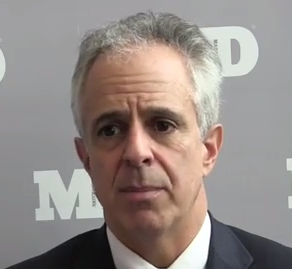Implantable Ranibizumab Port for Wet AMD Lasts Up to 15 Months
In a phase 2 study, a long-acting, implantable delivery system for ranibizumab allowed patients with wet age-related macular degeneration to go up to 15 months before requiring a refill.

Carl D. Regillo, MD
New data from the LADDER study of an implantable delivery system for ranibizumab (Lucentis) show that some patients with neovascular, or wet, age-related macular degeneration (AMD) were able to go 15 months between treatment visits. The updated results were presented at the American Academy of Ophthalmology 2018 Annual Meeting in Chicago, IL.
In a condition where injections every 6 to 8 weeks are the norm, a long-acting implantable system could improve adherence and prevent vision loss or blindness in patients with wet age-related macular degeneration.
The phase 2 LADDER study included 220 patients randomized to either 1 of 3 concentrations of ranibizumab (10 mg/mL, 40 mg/mL, or 100 mg/mL) in an implantable device or a monthly injection of ranibizumab (.5 mg). Outcomes included the time until a patient needed a refill of the implanted ranibizumab delivery system and the effectiveness of each concentration compared to monthly injections.
Patients treated with the highest ranibizumab concentration were able to go a median of 15 months before needing a refill, according to lead site investigator, Carl D. Regillo, MD, chief of retina service and professor of ophthalmology at Wills Eye Hospital in Philadelphia. Additionally, investigators found that the port delivery treatment was also as effective as monthly injections.
“Fewer injections and office visits is exciting,” said Regillo in a statement. “But more importantly, we think it will translate into better visual outcomes because in the real world, patients get less treatment than they need. It’s not done consciously. Over time, things happen: illness, hospitalization, a snowstorm, etc. and appointments are missed or delayed. If you’re a week or two late for a visit from time to time, you may have a decline in vision, and you can’t always recover from that. It’s a relentlessly progressive disease.”
Data from the LADDER study presented in a late-breaking session at the 36th ASRS annual meeting showed how many participants were able to wait at least 6 months before needing a refill. Of those patients receiving the 100 mg/mL ranibizumab, about 80% were able to go ≥6 months without needing to refill their medication. In the 10 mg/mL and 40 mg/mL groups, 63.5% and 71.3% were able to go 6 months or more, respectively.
The ranibizumab injection (Lucentis) was initially approved by the US Food and Drug Administration (FDA) in 2006. It is approved currently for the indications of neovascular (wet) age-related macular degeneration (AMD), macular edema following retinal vein occlusion (RVO), and diabetic macular edema (DME), diabetic retinopathy (DR), and myopic choroidal neovascularization (mCNV). According to the ranibizumab Prescribing Information, the most common adverse reactions (reported more frequently with ranibizumab than control) are conjunctival hemorrhage, eye pain, vitreous floaters, and increased intraocular pressure.